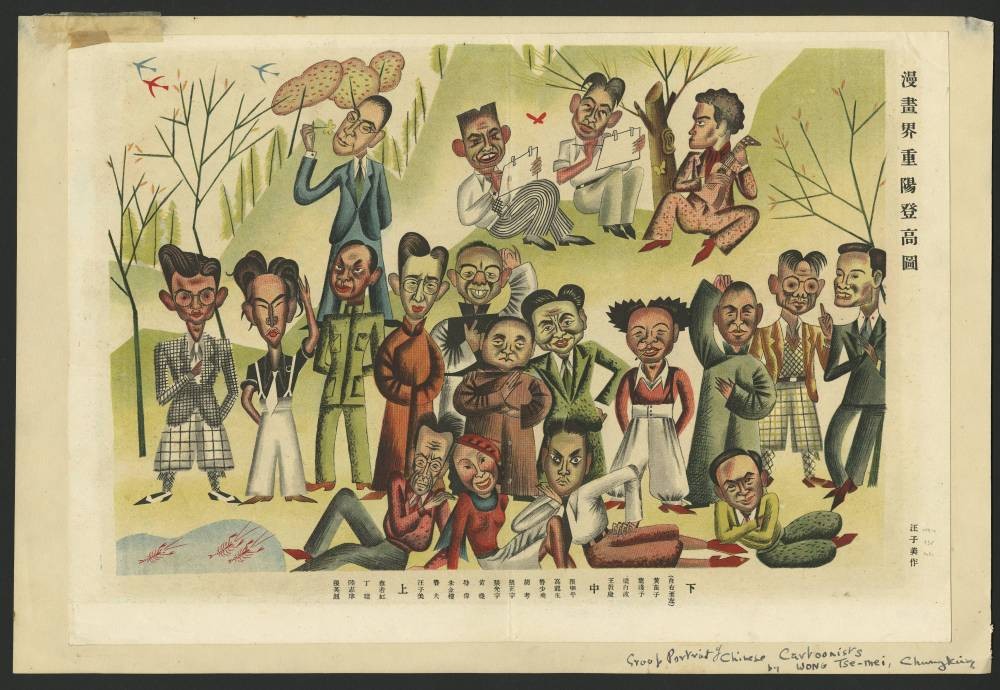Firsts are always controversial. If the first Chinese cartoonist was the student of another, earlier cartoonist or proto-cartoonist, either by instruction or by inspiration, then he wasn’t really the first Chinese cartoonist, was he?
In a way, it all depends on how broadly or narrowly you choose to define the word “cartoon,” or kǎtōng 卡通 or “comics” mànhuà 漫畫 in Chinese. Strictly speaking, the first time the word “manhua” was used to describe a cartoon-like drawing by a Chinese artist occurred when Zheng Zhenduo 鄭振鐸 published drawings by Feng Zikai 豐子愷 under that name in the periodical Literature Weekly 文學周刊 in 1925. Most scholars agree however that Feng’s work represents a synthesis of earlier works. Geremie R. Barmé, for example, has found particularly strong stylistic and thematic resemblances to the popular Japanese artist Takehisa Yumeji 竹久夢二 (1884-1934) whose work Feng was exposed to while studying abroad for 10 months in 1921.1
Chinese scholars Bi Keguan 畢克官 and Huang Yuanlin 黃遠林, meanwhile, have “[traced] a genealogy back to such pre-modern proto-cartoons as stone etchings (shike 石刻) from the Eastern Han dynasty (25–220 CE) and humorous brush paintings from the Ming dynasty (1368–1644).”2 These stone etchings were likely based on earlier works in more ephemeral media, like wood or paper, which themselves would have found inspiration in the oral tradition.
In short, it’s cartoonists all the way down.
More importantly, perhaps, as Tom Gunning points out in his landmark essay on “the first” fictional and comedic film (the Lumiere brothers’ L’Arroseur arrosé), the whole process of arguing over who is standing on whose shoulders can get in the way of looking at things which really matter, or as he puts it, “the issues history involves.” Even so, Gunning makes a good argument for paying attention to so-called “firsts” not so much out of respect for their chronological precedence, but instead to consider the ways in which they set a precedent for works yet to come:
“Firsts” are the bane of film history. Not only are they usually dubious (given how many films have disappeared), they also obscure the issues history involves. If this Lumiere film has a significance for the history and theory of film comedy…that significance comes precisely from the films that came after it, from the way it set up a widely imitated prototype.3
In this spirit, I think a strong argument can be made that it was not until the last decade of the 18th century that works which meaningfully anticipate manhua began to emerge, and that moreover the most influential “cartoonist” during this time period was the mysterious Wu Youru 吳友如 (1841-5?-1893?), one the most prolific “newspainters” of the late-Qing who created illustrations for the Dianshizhai Pictorial 點石齋畫報, published by the British entrepreneur Ernest Major’s 美查 Dianshizhai lithographic press4 in Shanghai from May 8, 1884, to August 16, 1898.5
- Geremie Barmé, An Artistic Exile: A Life of Feng Zikai (1898-1975) (University of California Press, 2002), pp. 52–71. [↩]
- Christopher Rea, ‘He’ll Roast All Subjects That May Need the Roasting’, in Asian Punches – A Transcultural Affair, ed. by Hans Harder and Barbara Mittler, pp. 389–422 (p. 392); Keguan Bi [毕克官], 黄远林 and Yuanlin Huang, Zhongguo manhua shi 中國漫畫史 [A History of Manhua in China] (Beijing: Wenhua yishu chubanshe, 1986), Beijing. [↩]
- Tom Gunning, ‘Crazy Machines in the Garden of Forking Paths: Mischief Gags and the Origins of American Film Comedy’, in Classical Hollywood Comedy, ed. by Kristine Brunovska Karnick and Henry Jenkins (New York: Routledge, 1995), pp. 87–105 (p. 88). [↩]
- itself a part of the larger press, Shenbaoguan 申報館, responsible for the first newspaper in China, the Shenbao 申報 [↩]
- Wagner, Rudolf G., ‘Joining the Global Imaginaire’, in Joining the Global Public: Word, Image, and City in Early Chinese Newspapers, 1870-1910 (SUNY Press, 2012), p. 131. It should be noted that Ernest Major himself left Shanghai in 1889, at which time the Shenbaoguan, and the Dianshizhai along with it, came under new management. Wu Youru left the press around the same time to start his own illustrated periodical, the Feiyingge Pictorial 飛影閣畫報. [↩]
